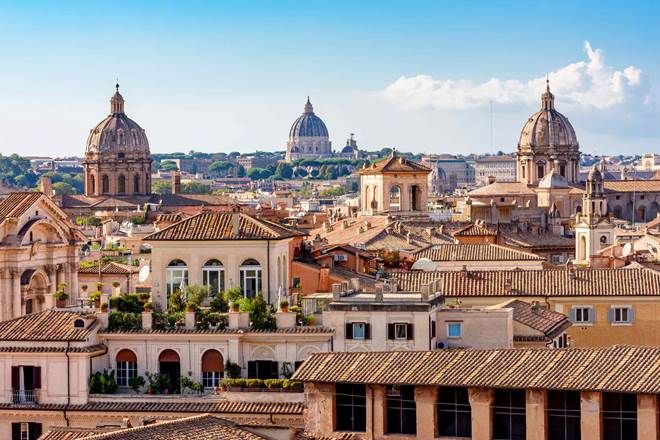What to do in Rome? What an impossible question!
Just listing the archaeological sites, museums, theaters, restaurants, and other attractions by name alone would make this article run longer than the Appian Way.
Rome’s history dates back nearly 3,000 years, and yet, its architecture and artwork continue to astound visitors of all ages. You don’t have to be a history buff to sit slack-jawed at Rome’s enduring and endearing sites.
Just walk by any restaurant and your mouth will water at the sight of cacio e pepe plates and tall glasses of Castelli Romani wine.
You can spend an eternity in the Eternal City doing nothing more than gazing at centuries-old frescos and gorging on handmade pasta. It’s a city all globetrotters must visit and one that’ll convince you to return again and again.
And, when in Rome, use the train to see and do as much as you desire.
Image Credit: Getty Images, Nicola Forenza. Image Location: Colosseum, Rome, Italy.
What to do in Rome, Italy, for first-timers
Whether you’re visiting Italy’s capital city to scope out the filming locations for Gladiator (or The Lizzie McGuire Movie, no judgments here) or are fulfilling a dream that started in your 6th grade history class, Rome’s top ten attractions should be at the top of your list.
- Colosseum, self-explanatory.
- Pantheon, one of the best-preserved ancient buildings in the city.
- Roman Forum, an astounding excavation of several ancient ruins.
- Spanish Steps, a perfect place to watch the sunset.
- Baths of Diocletian, ancient imperial thermal baths adorned with artwork.
- Castel Sant’Angelo, an imposing fort along the Tiber River.
- Capitoline Museums, some of the world’s oldest museums.
- Saint Peter’s Square, the grand entrance to Vatican City.
- Sistine Chapel, the Vatican Museums’ famous frescoed ceiling.
- Trevi Fountain, so you can toss a coin and guarantee your return.
Image Credit: Getty Images, Filippo Maria Bianchi. Image Location: Trevi Fountain, Rome, Italy.
Hidden gems for your return to Rome
Did you already veni, vidi, vici your way through Rome? Awesome; with the hallmark attractions checked off, you’re free to wander the lesser-trodden paths around the city.
- Pyramid of Caius Cestius, an Egyptian-style tomb decorated with frescos.
- Trajan’s Market, an impressive imperial museum with minimal crowds.
- Domus Aurea, what remains of Nero’s opulent villa near the Colosseum.
- Mausoleum of Augustus, a tomb built by Rome’s very emperor, Caesar Augustus.
- Capuchin Crypt, a small set of catacomb chapels, filled with thousands of skeletal remains.
- Largo di Torre Argentina, where the conspiracy to kill Julius Caesar took place.
- Via Appia Antica, the most important road in Rome, lined with historical landmarks.
- Museo Napoleonico, a collection of works and art donated by Napoleon’s descendants.
- Quartiere Coppedè, a fairytale-like neighborhood designed in wondrous architectural styles.
- Vatican Necropolis, a limited number of daily visitors can wander beneath the Basilica.
Image Credit: Getty Image, Alexander Spatari.
How to do as the (visiting) Romans do
How many days in Rome is enough?
At least 4 to 5 days provides the time needed to complete your itinerary at a leisurely pace while allotting time for a few other impromptu stops. If you’re short on time, you could check off hallmarks like the Vatican, Colosseum, and Forum within 1 or 2 rushed days.
Where should I stay in Rome?
Depending on your budget and interests, you’ll likely want to stay in an area of Rome close to the main attractions. Keep in mind that Rome’s metro system has stops near many of the popular sites, so you could potentially save money by staying just outside the city center and relying on public transportation.
Image Credit: Getty Images, Jullian Elliot Photography.
Is Rome a walkable city?
Yes, Rome is a walkable city, though you won’t want to rely on your shoes alone. Although attractions like the Colosseum and Forum are less than ten-minutes apart by foot, it would take an hour to walk from the Colosseum to the Vatican. Thankfully, the metro has stops near both sites so you can maximize your time and save your energy.
What’s the best way to get around Rome?
The metro and bus system is the best way to get around Rome. The three metro lines weave around 37 miles of Rome, stopping at or near popular sites like Roma Termini, the Vatican Museums, the Colosseum, and the Trevi Fountain.
Header Image Credit: Getty Images, Vladislav Zolotov. Image Location: St. Peter's Basilica, Rome, Italy.

